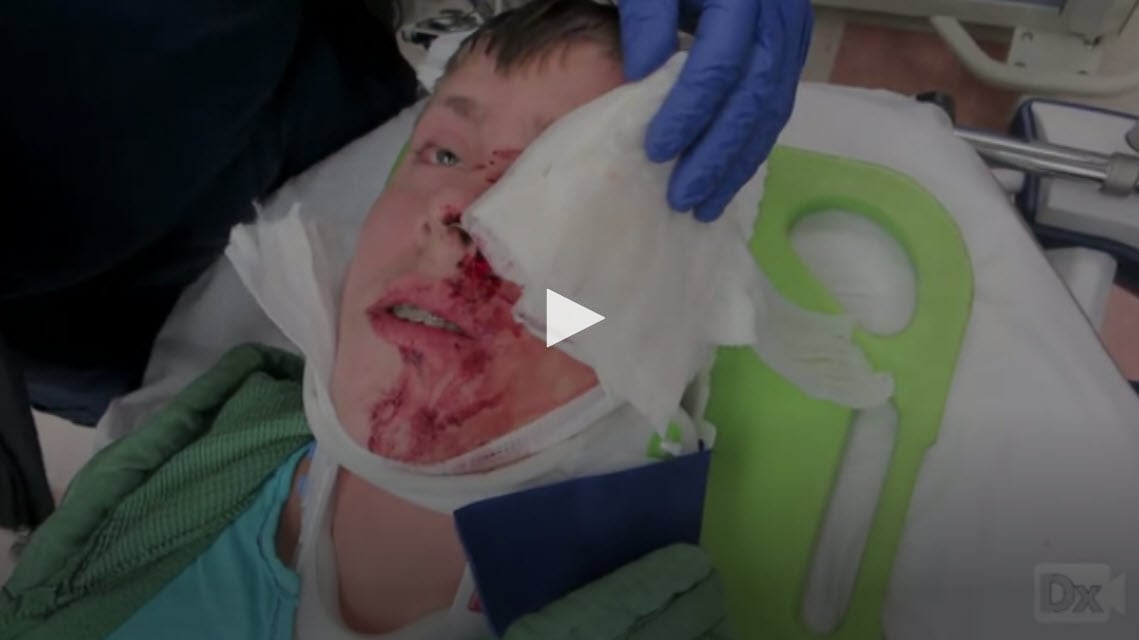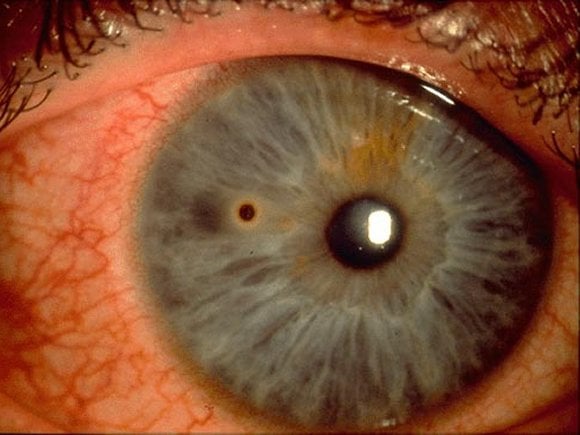18 y/o with facial and eyelid trauma after an MVA
Patient will present as → a 33- year-old complaining of right eye pain and irritation. He states that he wasn't wearing glasses, and while trimming his driveway with his weed trimmer, "something flew into my eye." Visual acuity is 20/20. Pupils are equal, round, reactive to light, and accommodation. Extraocular movements are intact. On physical examination, you note a tearing, red, and severely painful right eye.
An ocular foreign body is any object embedded in or adhering to the conjunctiva or cornea
- Metallic foreign bodies may leave a rust ring
- A foreign body trapped under the upper lid may cause one or more vertical corneal abrasions that worsen as a result of blinking
- Intraocular penetration can occur with seemingly minor trauma, particularly when foreign bodies result from high-speed machines (eg, drills, saws, anything with a metal-on-metal mechanism), hammering, or explosions
- If you can't remove the foreign body easily then refer to the ophthalmologist
Slit-lamp examination, usually with fluorescein staining with cobalt light illumination renders abrasions and nonmetallic foreign bodies more apparent.
- X-ray or CT may be necessary if there is evidence of penetration of the globe
If a corneal foreign body is detected, an attempt can be made to remove it by irrigation after the installation of a topical anesthetic
- This is particularly helpful in the case of multiple superficial foreign bodies (e.g., sand)
- An attempt can then be made to remove the foreign body with a swab, using direct visualization
Intraocular foreign bodies require immediate surgical removal by an ophthalmologist
- Systemic and topical antimicrobials (effective against Bacillus cereus if the injury involved contamination with soil or vegetation) are indicated
Rust ring — After removal of a foreign body containing iron, there is often a residual rust ring and reactive infiltrate. Patients with rust rings should be treated as patients with corneal abrasions. The rust ring itself is not harmful and will usually resorb gradually.
Question 1 |
MRI Hint: MRI should never be used when there is suspicion of an iron-containing intraocular foreign body. | |
X-ray orbits | |
Applanation tonometry Hint: Tonometry is used to evaluate intraocular pressure, but not the presence of intraocular foreign bodies. | |
Fluorescein angiography Hint: Fluorescein angiography is used to evaluate vessels of the eye, not intraocular foreign bodies. |
Question 2 |
Check visual acuity Hint: Delaying irrigation of the eye to assess vision or corneal damage is inappropriate as damage to the eye may occur during the delay. | |
Flush the eye with two liters saline | |
Check for corneal damage with fluorescein Hint: See A for explanation. | |
Instill a topical anesthetic to facilitate examination Hint: Topical anesthetic may be used to facilitate irrigation with a Morgan lens, but see A for explanation. |
Question 3 |
irrigate the eye for at least 20 minutes | |
apply Bacitracin ointment and patch the eye Hint: See A for explanation. | |
remove the sparkle with a moistened cotton swab Hint: See A for explanation. | |
protect the eye with a metal shield and refer to an eye ophthalmologist Hint: See A for explanation. |
Question 4 |
Administer tetanus Hint: Tetanus booster is only required every 5 years. | |
Prescribe Tetracaine ophthalmic Hint: See D for explanation. | |
Provide reassurance only Hint: See D for explanation. | |
Refer to ophthalmologist |
|
List |
References: Merck Manual · UpToDate




